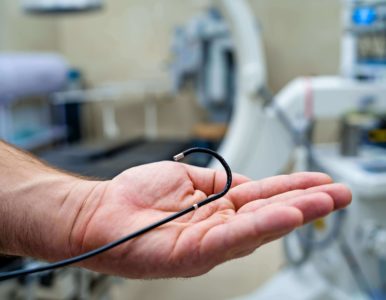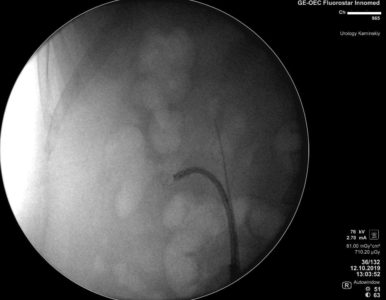Laser lithotripsy through the urethra (urinary tract)
Contact laser lithotripsy
The procedure involves bringing a laser fiber to calculi and destructing them to dust (laser effect) or smallest fragments with subsequent spontaneous passing or removal from the urinary system.
If the calculus is located in the ureter, a surgeon can reach it using a direct (inflexible or rigid) tool, however the closer the calculus is to the kidney, the more likely it will move into the kidney during lithotripsy and the rigid tool will no longer be effective.
In such a situation, a surgeon, who does not have a flexible tool and laser, should have to stop the operation without achieving a complete effect with further often migration of fragments into the kidney causing possible renal colic and complications in the future.
Therefore, the crucial condition for maximum efficacy of contact laser lithotripsy (retrograde surgery) is the ability to enter the body and destruct calculus in any part of the kidney or ureter with a flexible tool.
Based on the above, now we consider the strong and weak points of laser lithotripsy (retrograde surgery) through natural openings only if a surgeon has in his/her disposal direct and flexible tools and a modern laser unit.
Advantages of laser lithotripsy (retrograde surgery):
- fast and clearly predicted result;
- absence of a period of fragment passing associated with pain syndrome and a need for a large number of painkillers;
- ability to destruct calculi of any density
- absence of damage to the integrity of patient`s body, as all tools pass through the natural openings of the body;
- possibility of visual and radiological control during surgery to reduce the risk of large fragments being left behind;
- high efficiency of the method with minimal injuries;
- absence of pain during surgery as it is performed under spinal or general anesthesia;
- retrograde surgery is a one-day procedure with a short postoperative period when, in the absence of complications, a patient can return to everyday activities the next day without any external drainage.
Disadvantages of laser lithotripsy (retrograde surgery):
- the necessity to enter the patient`s body
- in about 10% of patients it is technically impossible to approach calculus due to natural urethral contractions, anatomic flexures or other features (in this situation, the patient is installed a stent/internal drainage to expand and align the urinary tract, and 90% of patients become passable to approach calculi in two weeks);
- the need for spinal or general anesthesia;
- the need for hospitalization of the patient for one day;
- the need to install a stent (internal drainage) after the operation, and remove it in 1-2 weeks.



